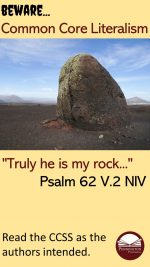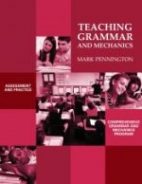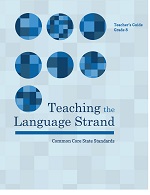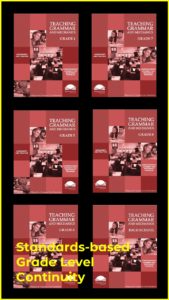Common Core Literalism
In Psalm 62 Verse 2, David talks about God saying, “Truly he is my rock...” (NIV)
Now, no one I know would interpret this verse as claiming that God is igneous, sedimentary, or metamorphic. This “anyone” would also include children. After all metaphor is a grade 4 Standard: “Explain the meaning of simple similes and metaphors in context. CCSS.ELA-Literacy.L.4.5.b.
Obviously, David did not mean that God is literally a rock. However, this is not quite the meaning of literally. Technically speaking, we should take what David wrote literally because literally means “as it is written.” An easier way to understand the word, literally, would be “as it is intended.” In other words, David intended to use a metaphor to describe the character of God; that is how it is written.
However, many educators are taking the Common Core State Standards (CCSS) in a wooden literal sense: not at all in the ways that the Common Core authors intended the Standards to be used. The point I’m getting at is that the CCSS authors intended the Standards to provide a common ground for grade-level teaching, not an all-inclusive, detailed instructional scope and sequence. Last I checked, the 10 Common Core Standards were not written on two stone tablets!
Additionally, when educators look at the CCSS appendices, is is clear that the authors trust administrators, teachers, and publishers to exercise some judgment regarding the implementation of the Standards. This is especially true with necessary prerequisite skills and with remediation.
As an educational publisher I am constantly placed into “no-win” situations in which some school districts are demanding the citation of the specific CCSS Standard on every activity, lesson, worksheet, etc. I could comply with their demands and fudge some of the Standards (as is the usual practice of most educational publishers, use the more generic Anchor Standards, or choose to lose the sale. I choose to lose the sale in these cases, but I always try to explain why I won’t fudge the Standards citations.
To illustrate the problem, here’s a recent exchange from a preschool/transitional-K/kindergarten classroom teacher, who happens to sell her curricula on Teachers Pay Teachers.
Teacher: I’m trying to add the Common Core Standards to my Alphabetical Order resources. I can’t find anything anywhere! Am I missing it? I know other teachers besides myself teach it, as the resources are selling. Or is it one of those things like Patterning where it is still taught by some just not emphasized?
Other Teacher: I’ve looked, too. It’s not a Standard.
Pennington Publishing: This raises an important point. As a reading specialist, I would certainly argue that knowing alphabetic order, as well as recognition, matching, and replication of upper and lower-case letters are critically important prerequisites for reading.
Yet, as others have said, these are not detailed-out in the CCSS.
I recently lost a potential school-wide sale via my Pennington Publishing store because I answered a principal’s question honestly.
She was asked by her reading intervention teachers to purchase my Teaching Reading Strategies and Sam and Friends Guided Reading Phonics Books BUNDLES. She asked me, “Are your assessments and teaching resources Standards-based? Are they specifically aligned to the Common Core State Standards?”
I answered, “Yes, my assessments and corresponding teaching resources are aligned to the Common Core State Standards as detailed in Appendix A. Because the assessments and resources are remedial-based, they encompass multiple grade-level Standards and the prerequisite skills articulated by the Common Core authors that are necessary to scaffold these Standards.”
The principal couldn’t buy my programs because I could not place a specific Common Core Standard on each and every activity, worksheet, story, etc.
Now, I do develop curriculum to specifically address the CCSS and I provide alignment documents in each of my ELA and reading intervention programs. However, we’ve got to give the Common Core authors some credit. We can’t make the Standards “walk on all fours.” Some Standards are stated generally; others with specificity. Some Standards list examples; some do not. I know some teachers who will only teach the examples given in the Standards and none others. That’s crazy. The Common Core authors expect that teachers will need to fill-in-the-blanks. The Standards were not intended as educational straight-jackets.
Teacher: Thanks for sharing your story. I’m sad that you lost a sale, but it’s good to know that there are others who share my belief that prerequisite concepts are missing at certain levels of Common Core.
We all had to learn to crawl before we could walk. So, when my students are ready, I will continue to teach those missing prerequisite materials. It can only help them when they move on to the next grade level.
I’m glad that this teacher is exercising such good judgment. She is teaching the CCSS literally–as the authors wrote them and intended the Standards to be applied in classrooms throughout the United States. She is teaching the Standards with fidelity. I would argue that teachers who are teaching grade-level Standards in a wooden literal sense are not teaching really teaching the Standards.
As a case in point, the CCSS Speaking and Listening Standards and Reading: Foundational Skills Standards make only scant mention of syllable awareness (primary), syllable rules (intermediate), nor accent rules (secondary). However, every teacher would place importance on these instructional elements.
Syllabication is for all ages. Download these FREE instructional resources for your students:
Get the Syllable Awareness Assessment FREE Resource:
![]()
Get the Syllable Rules FREE Resource:
![]()
Get the Accent Rules FREE Resource:
![]()
Grammar/Mechanics, Literacy Centers, Reading, Spelling/Vocabulary, Writing










 I hear the same two comments at English-language arts conferences all the time:
I hear the same two comments at English-language arts conferences all the time: